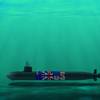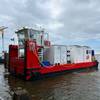Royal Australian Navy officers were amongst the first to graduate from the new AEGIS combat systems course delivered at the Combat Systems Engineering Development Site in Moorestown, New Jersey after completing a thorough and rigorous two months of training.
Dr Darrell Tatro, director, Center for Surface Combat Systems International Programs, presided over the ceremony.
“Today’s milestone event is the result of CSCS partners coming together to develop the Combat Systems Officer course that provides a combination of functional and operational systems instruction with warfighting applications applied for the newest Air Warfare Destroyers, which are equipped with the AEGIS Combat System,” Dr Tatro said.
“The instruction, hands-on labs, simulations, as well as computer-based and interactive courseware training provided you the knowledge and tools to help you and your future crews implement and execute AEGIS.”
Concurrently, Australian officers attended the Prospective Commanding Officers and Executive Officers Courses to develop command level knowledge in the operational characteristics, capabilities, limitations, and administrative requirements of the combat system in a fleet environment.
“What made this course unique is that Australian Navy students were able to participate in multiple guided discussions with subject matter experts with AEGIS Combat System experience, including Captain Pete Galluch, commanding officer of the AEGIS Training and Readiness Center,” Dr Tatro said.
“Discussions included use of the combat system in strike group operations and AEGIS lessons learned in tactical situations.”
Royal Australian Navy’s Director Destroyers, Captain Terry Morrison, will introduce the elements of training for the Hobart class destroyers, says both courses were essential because of their focus on the combat systems training experience.
“From beginning to end, each course provided us an in-depth knowledge of combat systems training which will empower us to do our best of delivering this future capability to our Navy,” he said.
Commander Rich Petrie, also a student, will return to Australia to stand up Hobart’s crew.
“The training scenarios that we received were very realistic to the ship’s environment and it was crucial that we experience the new baseline first hand that our Navy will be utilising for years to come,” he explained.
Commander Josh Wilson, who will return to Australia to develop the tactical and operational portions of combat systems training for future crews, looks forward to commissioning the second ship, HMAS Brisbane.
“I have received in-depth training in the States before but to work on the live baseline with experts side by side was extremely beneficial,” he said.
“What I have learned and will execute will positively impact the Australian Navy’s future generation of sailors.”
Captain Morrison, and Commanders Petrie, and Wilson look forward to continuing their relationship with their US counterparts when they travel to Australia to conduct additional training.
“The Australian Navy has extensive experience working with the US Navy,” Captain Morrison said.
“It was a privilege to work with them again and I look forward to furthering our partnership when they travel to Australia.”
Dr Tatro stressed that the partnership would continue to grow with the progress of the Air Warfare Destroyer program.
“It will only get stronger and both the RAN and USN are confident that you have been provided the tools to help shape the Australian Navy today and tomorrow’s global AEGIS fleet.”










